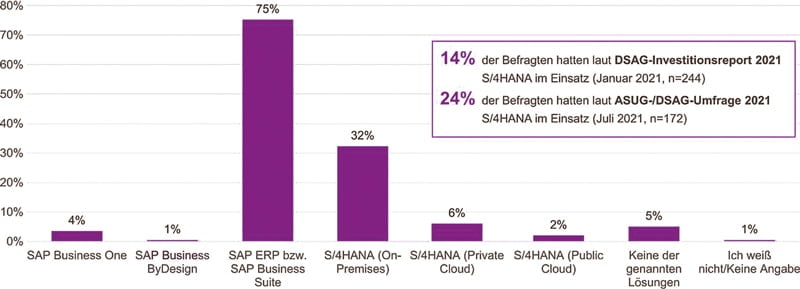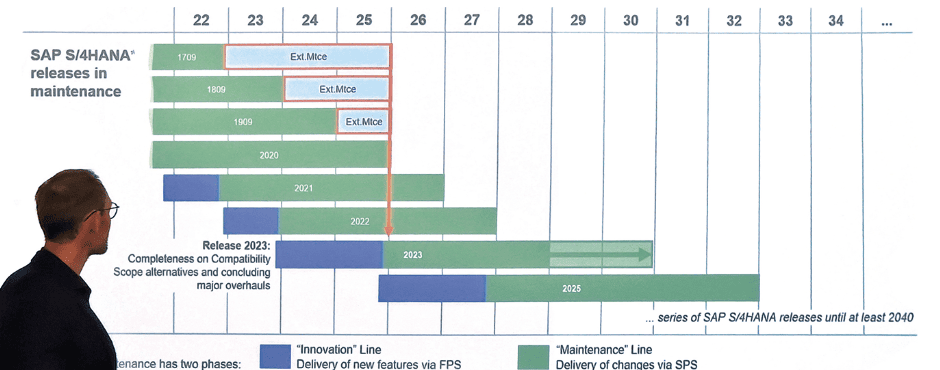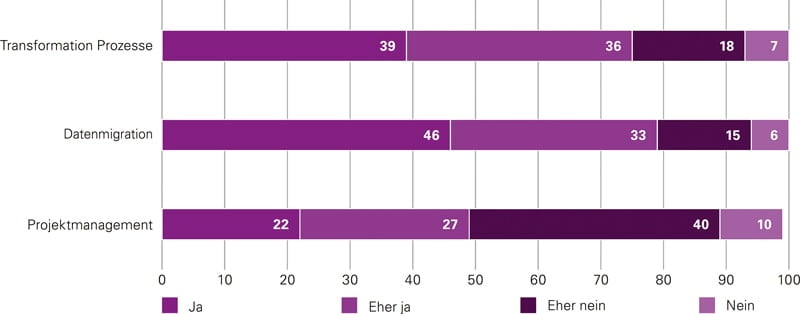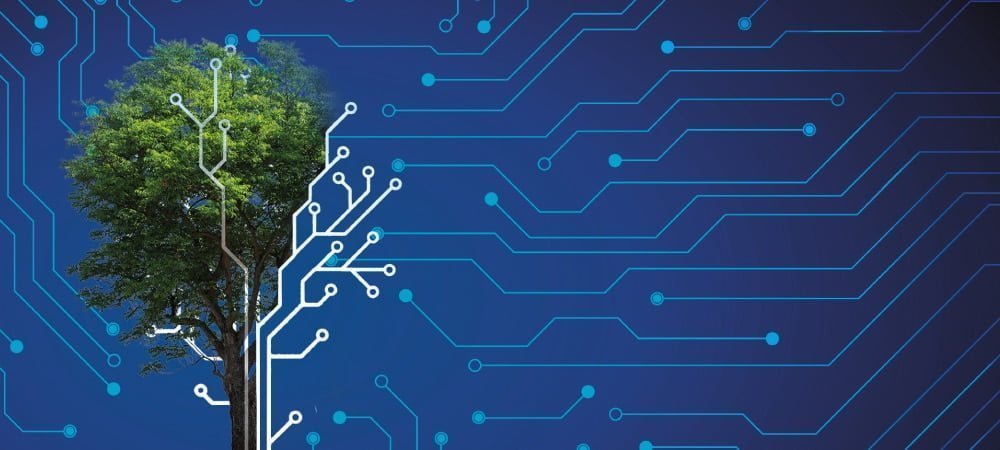The path to the data-driven enterprise


One-Click Transformation, S/4 Hana Conversion and SAP Customer Evolution
Data is more than knowledge and information. In modern ERP systems, master data controls business processes. At the latest when it becomes clear how great the effort alone is for the migration and transformation of the legacy data into the new system, completely new solutions are required. No longer a multitude of different tools, but a platform that provides these different tools as a function; no longer all data, but only the right data; no longer simply data, but only data of the highest quality. Only then can companies return to the SAP standard, allow their CFOs and specialist departments to access legacy data and still only transform and migrate a small part of it to the new system, as well as clean up erroneous and redundant data records in order to start with only high-quality data in S/4.
With the right platform, companies can extract their legacy data from legacy systems at the push of a button and in a highly automated manner, store it in a legally compliant manner, cleanse and optimize it, transform the optimized master data and only the operational data that is really needed, and migrate it to a new S/4 Hana system via an application layer using SAP's standard tools such as Conversion Tool and Migration Cockpit.
Data Fabric
But that is by no means all. Such a platform for transformation at the push of a button is the ideal introduction to the data fabric, as the analyst firm Gartner calls the concept of a continuous separation of corporate data from the application layer. This data fabric forms the basis for the data-driven enterprise. By making data available together with its business context in optimal quality, it can be analyzed in real time to gain valuable insights for business decisions. This is all the more successful because the company information on the platform can be enriched and refined with further data from surrounding systems of the SAP core, including cloud applications. Incidentally, this pioneering one-click transformation approach by DMI and the associated platform for information management, JiVS IMP, help to avoid vendor lock-in. This is because the data always remains accessible to the companies, even if they change or switch off their applications - whether on-prem or in the cloud.

Central system SAP
As in the past, the heart of corporate IT will continue to beat in the SAP system. This is where all the value flows of a company are mapped in a highly integrated manner. Nothing can replace this. Even the most popular third-party solutions, especially those in and from the cloud, are and remain peripheral systems of the SAP core. The return to the SAP standard during the transformation to S/4 together with quickly implemented and provided individual adaptations via low-code/no-code, for example via SAP's Business Technology Platform, is the logical business case.

S/4 and JiVS
SAP S/4 Hana and JiVS IMP as an enterprise-wide data fabric support agile business scenarios such as mergers and acquisitions, carve-outs, consolidation of IT and data center locations, Big Data and analytics, and system rightsizing at the push of a button, since all data that is no longer required operationally, together with its business context, is available on the DMI platform in a legally secure and permanent manner for a wide variety of application purposes and business scenarios.
With the aid of transformation tools, it is possible to determine in a very short time which data will be transferred to the potential buyer in a carve-out and in what quantity. If data extraction and transfer are then actually to take place, the filter criteria are transferred to JiVS IMP and applied there. The preparatory work that a company has done for this scenario can be reused. For example, for the dissolution of a data center site or for the transformation to S/4. With DMI's service, companies achieve synergy effects in their transformation projects and can further simplify and accelerate them.
One-Click-Service
Although the end of ERP/ECC support is fast approaching in 2027 and 2030 at the latest, 75 percent of SAP users in German-speaking countries are still running ERP/ECC 6.0 and SAP Business Suite 7, according to the DSAG Investment Report 2022. And just under half of those using S/4 on-prem are continuing to run their old SAP systems in parallel. Under the given conditions, existing SAP customers are still looking for the business case for the changeover. It is most likely to pay off for start-ups and companies that are completely turning their business model upside down.
Then the legacy data can stay where it is. In return, the companies start anew with an empty S/4 system. Everyone else, however, is faced with a poor alternative: complete or partial transfer of business objects, individual adjustments, and data and its structures as in the legacy system. This is technically feasible, but forces companies to forgo innovation. As the saying goes: nothing but expenses.
The KPMG report "S/4 Hana with perspective" states that the greatest needs are in the areas of process transformation and data integration. It becomes clear here that the use of qualitative resources as opposed to quantitative resources is the real challenge. According to KPMG, this result once again underscores the formulated idea of how important the right methodology is.
Qualitative resources
Paradoxically, many existing SAP customers therefore put off the necessary changeover to the new software generation from Walldorf because there is a lack of methodologies. DMI's answer with One-Click-Transformation on the JiVS platform and SAP's answer with the Customer Evolution program corresponds precisely to this previously missing methodological approach for S/4 conversion.
In the new S/4 world, SAP legacy customers only need about ten percent of the dataset for processing, only about half of the business objects and about twenty percent of the previous document types. However, this major cleanup will only succeed if the basic problem of dealing with legacy data is solved. The solution is to separate the data level from the applications and outsource the data from the legacy systems unchanged to a separate platform.
The crucial difference to an archive is that the business context is also outsourced and retained. In addition, the platform concept is essential. After all, it's not just about audit-proof long-term storage to meet legal requirements. To enable companies to manage their information independently of legacy applications and systems, a platform must include many different functions for a wide variety of scenarios.
With One-Click Transformation and SAP's Customer Evolution, decision makers can support a wide range of business cases: a fast and lean transformation and migration to S/4 and a return to the SAP standard; acquisitions and sales of companies and parts of companies; the complete decommissioning of legacy systems, not just their dismantling; consolidation of data centers and IT environments; permanently lean S/4 systems; migration to the cloud and back again; and last but not least, analytics and data governance.
Quantitative data structures
DMI can prove from experience in over 2000 projects worldwide that decommissioning legacy systems reduces costs by 80 percent or more compared to keeping them in operation. The effort required for data transformation and migration is reduced by half. And the Swiss provider estimates that total cost of ownership will fall by a quarter if companies keep S/4 permanently lean using its JiVS IMP platform. This means that the long-sought business case for switching to S/4 Hana has finally been found.
CEOs, CFOs, DIOs, board members, general managers, department and division heads, and business users outside of IT often don't think about where the data comes from. But just as electricity doesn't just come out of a wall socket, enterprise data isn't accessible to anyone and everyone at any time. Of course, data exists. Data is available in a wide variety of formats, in a wide variety of storage devices, and in a wide variety of quality. And thanks to cloud services and the Internet of Things, new data formats and sources are constantly being added. IT departments have already tried in the past to provide and analyze data for their bosses for process and company control.
Since then, they have known that this task is hardly manageable. Because by the time the data experts had built the interfaces to the various data sources and defined the transformation rules, the business had already made changes again. The data they had painstakingly collected for business control was therefore already outdated again by the time they evaluated it.
However, the time gap is only one problem that companies must eliminate on the way to data control. Equally obstructive is the fact that important information is necessarily always lost when data and its structures are harmonized. But this information is essential for analysis and control. To understand why customer revenues are declining, it is not only the declining revenues that are important. Those only describe that a company is selling less, not why. The reasons are more likely to be found in customer correspondence, which is linked to sales. But if the data is separated from the context and stored in archives and the like, company managers are missing precisely the crucial information.
Analysis and control
It is therefore less surprising than it might seem at first glance that so many data projects for business management fail or do not produce the results that those responsible hope for. To succeed, companies need to preserve data along with its context and make it available for analysis and insights, and optimize it. But this is not so simple. After all, there are major dependencies between the data, its structures, and the systems and applications in which it was created.
These dependencies are like the walls of a silo. And there are a lot of them, especially in large and very large companies. In recent years, CIOs have invested a lot of time and money in tearing down these walls, especially with the help of the cloud. But in doing so, they have found that they have created new silos. That is dangerous. Time and again, there are reports in newspapers about people who have met their deaths in silos. So the data problem is pervasive. But boards of directors usually only deal with it when there is a generational change in central enterprise applications such as ERP systems.
Companies would prefer to take all legacy information with them into the new world, but to do so they must change its structure. At the same time, they have to find a solution by law to keep this information unchanged. Companies mistakenly assume that this can only be done with the help of the legacy system, which they therefore continue to operate until the legal deadlines have expired. This is exactly the pattern that threatens to repeat itself when switching to SAP S/4.
The continued operation of legacy systems is costly. To save time and money, IT massively restricts access to them. This, in turn, is a serious nuisance to colleagues from the specialist departments, but especially to the CFO. Their position is that it is best to have access to the entire data stock at all times and not just during internal audits or audits by the tax office. In many companies, bitter trench warfare rages between these two extreme positions. And even where there is a will to reach agreement, the situation resembles haggling among traders at the cattle market. IT provides access to the last three years of data. The CFO demands at least ten years. And in the end, they agree on five years - a lazy compromise.
The worst part is that any lazy compromise means night shifts for IT. Even five vintages of legacy data correspond to huge amounts of data in large and very large companies. The fact that CFOs and business departments can use them in the new system does not justify the associated transformation and migration effort.
Legacy data and standards
Management wants to modernize and digitize business models and processes. When switching to S/4, this means cutting old ties and returning to the standard that SAP specifies. This includes reducing individual customizations to a minimum and rebuilding them as needed. Many of these originate from the past and no longer make sense today.
Even management decisions that are now commonplace, horse-trading in legacy data makes it a real problem for IT. These include, for example, acquisitions and disposals of companies and business units. It is difficult to impossible to extract and transfer exactly the information that buyers and sellers are allowed and required to have in a highly individualized SAP system with a dataset of twenty years or more. It is just as difficult to take off with this legacy in your luggage after the switch to S/4 Hana thanks to new processes and by means of data control.
Even more serious from a business perspective, however, are the dependencies between the data, its structures and source systems, but also from interfaces between different systems. Incidentally, this also includes those data that are, for the most part, unfortunately hardwired to obsolete or numerous organizational units, document types and processes that are no longer relevant. In many cases, this data is likely to account for up to 90 percent of the total data inventory. In fact, the dependencies are so great that they destroy the opportunity for a fresh start or the foundation for new business models and processes that management in most cases associates with generational change.

Master data cleanup
Incidentally, solving this fundamental problem of dependencies has only minimal chance of success, whether companies try to solve it at the source system level, i.e. before the changeover, or afterwards: This is because it is virtually impossible to clean up master data with relationships to outdated data structures, let alone arrive at a harmonized, i.e., cross-system, view of master data, which is usually distributed across several different source systems. The reason is that SAP legacy customers have to deal with extreme dependencies in this process, such as thousands of documents that are not closed; in some cases, it may not even be possible to get the data out of the archives, whose technology in many cases dates back to the 1990s.
In short: The linking of master data with transaction data and individual adjustments in the legacy systems prevents or at least massively complicates their cleansing. And since the relevant master data is usually found in not just one, but several and different systems, the problem is magnified. This is because these different master data from different systems would first have to be harmonized before conversion, which in turn prevents the dependencies. The vicious circle is perfect. Overall, however, the associated effort for both the business departments and IT cannot be justified.
However, even when IT prevails over business, selective data transfer proves suboptimal in many cases: First, this approach works mainly when the source and target systems are very similar, i.e., when it takes place between the latest ERP/ECC version and SAP S/4, for example. Second, the selective data transformation tools that work at the table level can introduce the risk of inconsistencies. Who can guarantee that direct table-oriented loading of records into 100,000 tables and more will be error-free in the case of large SAP environments?
It is true that this risk can be contained with a very high level of testing. But even this generally only helps to a limited extent in cleansing the data in order to optimize its quality for the new system world. Accordingly, companies have only limited options for ensuring a harmonized database that is fed by data from both SAP legacy systems and third-party systems. However, this harmonization option is an essential prerequisite for realizing the goal of a data-driven enterprise. The fact that data and its interdependencies represent the fundamental challenge in the SAP generation change is a realization that is just now gaining traction in the SAP community. So what can companies do? Can they just choose between the disadvantages of the different approaches?
Transformation: radically simple
The prerequisite for this is that the transformation takes place at the application level independently of the data level. To this end, it must be possible to extract all legacy information together with its business context completely, unchanged and, above all, efficiently and quickly and transfer it to a separate platform. To this end, the information from the legacy systems that is also needed in S/4 must be able to be filtered out, cleaned up, enriched with data from third-party systems and optimized on a separate platform according to business criteria. While companies generally only have to transform and migrate five to ten percent of the transaction data to SAP S/4 after optimization, the amount of master data is reduced to an estimated twenty percent, which they can then also transfer in optimal quality using standard tools such as SAP's Migration Cockpit. All of this must be automated.
At the same time, this platform must be able to display the historical data in the S/4 world via SAP GUI or SAP Fiori as if it had originated there. This on-the-fly transformation via the "technical structure mapping" process - without, of course, changing the original structure of the historical data on the platform itself - must also take place automatically. This level of automation from data extraction to display in the new environment is the essence of a one-click transformation.
All information - historical and operational - can be cleansed, easily enriched with data from third-party sources and optimally prepared for big data and analytics scenarios. Incidentally, this applies not only to movement data, but also to all master data, including the customer, supplier, article and material masters that are so important for digital transformation.

Find relevant criteria
In addition, the decision as to which information the companies should transform from the previous data stock and migrate to S/4 is strictly based on the relevant business criteria in each case. Instead of transferring all data from the last three years, for example, companies can consciously decide to transform and migrate only the open orders and master data on customers and suppliers with whom they have ongoing business relationships.
And the CFO and business can also be placated in this scenario: Because if CFOs and business departments argue and sometimes annoy their IT colleagues by saying that they need all the legacy data in the new system, then there is a misunderstanding here: What they actually need is not the historical data in the new system, but "only" access to it from the S/4 interface. With the one-click transformation approach, this works without a hitch. Users do not even notice when they access historical data that it is not in the SAP Hana database.
Once the historical information is transferred to DMI's platform, the legacy systems and applications are completely decommissioned. This typically eliminates 80 percent of the operating costs. The time and costs required for the actual data filtering, transformation and migration are reduced by half. These are the main findings and experiences from more than 2000 projects worldwide with JiVS IMP. Since the new data added to the S/4 world can be continuously transferred to the platform, the new environment and in particular the in-memory database Hana remain permanently lean. The savings potential that can be achieved through this continuous rightsizing is likely to be 25 percent or more over the entire lifecycle of the new environment.
The One-Click Transformation approach is characterized in particular by the consistent and continuous separation of historical data from operational data. The consistent separation between data and algorithms is also unparalleled in the market. This solves the fundamental problem of the dependencies described above. But the massive savings in transformation and operating costs, as well as the expenses for data cleansing and harmonization, are by no means everything. This is because JiVS IMP also preserves the transformation knowledge and makes it permanently available: for accessing historical data from S/4 Hana, for accessing historical data from non-SAP systems and for making this data available for third-party applications such as analytics solutions.
Platform thinking with DMI
Key benefits of the JiVS IMP platform: 80 percent lower operating costs, 50 percent lower data migration costs, 100 percent legal certainty, 25 percent lower TCO for S/4. The most important technical feature of the DMI platform is its high degree of automation: from the extraction of data from the legacy systems and their harmonization and optimization, through the transformation and migration of business objects via application layer, to the
automatic transformation to display the historical information in SAP S/4 as if it had been generated there.
The One-Click Transformation opens up a completely new dimension in terms of digital transformation in general and the switch to S/4 in particular. This approach is rounded off, completed and refined by the extension in the direction of transformation as a service. To this end, Data Migration International has developed a software-as-a-service solution. The idea behind this cloud service is that companies can run through and prepare their planned transformation projects with just a few mouse clicks. To do this, they do not have to reveal any real data from their systems. Rather, the service works exclusively with metadata. This makes IT as agile as the business and makes the vision of a data-driven company a reality.






